
Clear Lake
Riding Mountain National Park
Clear Lake through the years
Prior to 1871 – Mekis, Keeseekoowenin, and Okanase resided in the Noozaawinijing and near what is now called Clear Lake. Originally known as the Indians of Riding Mountain, the Riding Mountain Band, and the Keeseekoowenin Band, they are now known as the Keeseekoowenin Ojibway First Nation (KOFN), successors to the signatories of Treaty 2.
1896 – A fishing station was established at Clear Lake and designated as IR 61A for the KOFN.
1917 – Recreational use and cottage starts at Clear Lake. At the time Riding Mountain was a Dominion Forest Reserve.
1930 – Riding Mountain National Park is established.
1930 – With the establishment of the park, the fishing station at IR 61A for the Keeseekoowenin Band on Clear Lake is wrongly removed.
1936 – Members of KOFN residing at IR 61A were forcibly removed from their homes.
1991 – After lengthy land claims negotiations, the fishing station IR 61A was returned to the KOFN.
1998 – The Ministerial Agreement to establish the Senior Officials Forum was signed and continues to facilitate the act of reconciliation and foster positive relationships between Parks Canada and KOFN. A cooperative agreement to manage the fishery and water of Clear Lake was a shared interest identified in the park management plan.
2004 – Drinking water treatment upgrade.
2007 – All internal combustion marine outboard motors used with the park required to be either 4-stroke or direct injected 2-stroke.
2008 – First phase of wastewater infrastructure improvements are completed including the replacement of the wastewater forcemain, increased capacity of the sewage lagoon, alum used to precipitate phosphorus out of the effluent, and more properties hooked up to the townsite’s wastewater treatment system and not using septic systems.
2010 – 2012 – Wastewater treatment facility upgrade.
2010 – 2011 – Golf Course maintenance compound contaminated site remediation.
2011 – Townsite washroom parking lot contaminated site remediation.
2013 – Water and sewer hookup in Wasagaming Cabin Area.
2014 – Severely eroded shoreline along the northern edge of Clear Lake at the Aspen picnic area is remediated with a rock barrier.
2015 – Mandatory inspections for aquatic invasive species begin for all watercraft.
2016 – Boat launches consolidated as a result of the ongoing threat from aquatic invasive species, particularly zebra mussels.
2016 – New launch pads and new canoe/kayak launches installed at Boat Cove.
2018 – Stormwater infrastructure improvements to be completed.
2018 – Wasagaming Gas Station (122 Wasagaming Drive) contaminated site remediation.
2018 – On the 20th year of the signing of the Senior Officials Forum, Parks Canada Agency and KOFN have a tentative agreement to cooperatively manage Clear Lake, work towards developing a KOFN Fisheries Management Plan, and work towards a Clear Lake Area Strategy.
Overview
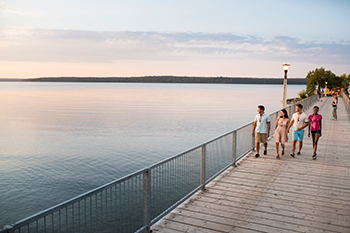
A 2009 VIP survey found that many visitors entering Riding Mountain National Park were repeat visitors, many of which have returned to the park for over 10 years. Clear Lake’s clear and healthy water provides the perfect opportunity for beachgoers, anglers, and boaters to get outside and enjoy time in or on the lake. The lake provides a beautiful scenic backdrop for those who want to walk, hike, or bike around the lake, to picnickers at the various day-use areas around the lake, and to golfers at the nearby Clear Lake Golf Course. Cottage owners see economic value in Clear Lake, as their property value is directly related to the proximity and health of the lake.
Lake ecology

Clear Lake is a unique lake for the prairie parkland area. It is oligotrophic, meaning it has low amounts of nutrients in the lake, giving it a clear look and making it a suitable source of clean, fresh drinking water. Clear Lake is surrounded by the Boreal Plains forest ecozone, a mix of boreal forest and prairies, which acts as an important natural water filter for pollution and nutrients.
Clear Lake is key habitat for 14 fish species, including whitefish, northern pike, white sucker, walleye, and slimy sculpin. Whitefish are the most abundant large-bodied fish in Clear Lake and are usually found in the deeper parts of the lake with slimy sculpin. Both of these species are considered ecological indicators of the health of the lake as they require a well-oxygenated lake bottom to survive.
Importance of Clear Lake to Indigenous Peoples

Indigenous peoples have inhabited Noozaawinijing or Wagiiwing since time immemorial. It is sacred to the Anishinabe and that sacredness is strongly tied to the waters of Clear Lake.
The Keeseekoowenin Ojibway First Nation (KOFN) maintain authority and control of IR 61A on the northwest shores of Clear Lake. In 1896, a fishing station was established on Clear Lake for the Riding Mountain Band as signatories of Treaty No. 2. This fishing station was wrongfully included within the boundaries of RMNP when it was established in 1930. IR 61A was returned to KOFN in 1991 after years of negotiated land claims. Today, cooperative efforts between KOFN and RMNP continue to respectfully monitor fish and their habitat in Clear Lake and work to foster positive relationships between Parks Canada and KOFN.
Parks Canada engages with the Coalitions of First Nations with interest in Riding Mountain National Park multilaterally at the Riding Mountain Forum (2006) about any number of initiatives involving waters in RMNP. Parks Canada also bilaterally engages with KOFN at the Senior Officials Forum (1998). Both forums convene regular meetings shared interests and implement goals established in the Park Management Plans regarding the waters in Riding Mountain National Park.
Some of the projects worked on in collaboration with KOFN and other Coalition First Nations include:
- Monitoring native cold water fish species
- The monitoring of traditional Indigenous harvest of whitefish, northern pike, walleye, cisco, and other fish species in Clear Lake
- Developing sustainability targets for cold water fish species
- Working towards the approval of cooperative management agreement
- Archaeological work including a dig at the Clear Lake Boat Cove as part of Boat Cove redevelopment
What we're doing to protect Clear Lake
Projects are ongoing at Clear Lake. The Clear Lake Conservation and Restoration (CoRe) Project (2014-2017) built on the previous Keeping the Clear in Clear Lake Action on the Ground I & II Project (2009-2012), and the Ecological Integrity Fund Project (2006-2009). The project was created to increase visitation by enhancing visitor experience while focusing on preserving the ecological integrity of Clear Lake. It accomplished various goals over three years, including the re-establishment fish habitat on Bogey Creek, upgrades at the Clear Lake Boat Cove, and the creation of interpretive programming such as canoe/kayak experiences and Learn to Fish.
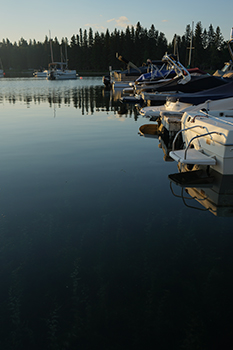
Cleaner Motors, Cleaner Water: As a result of public consultation, a decision was made by Parks Canada in 2001 to move towards protecting park waters by only permitting cleaner marine motors. In order to reduce emissions within Riding Mountain National Park of Canada, all internal combustion marine outboard motors used within the Park must be either 4-stroke or direct injected 2-stroke engines effective January 1, 2007. Older, outboard motors, particularly conventional 2-strokes, can release up to 30% of their fuel unburned into the water or air via exhaust. Marine motors that produce lower emissions contribute to a cleaner and healthier environment.
Aspen Picnic Area Shoreline Remediation: Severely eroded shoreline (first photo) along the northern edge of Clear Lake along the Lake Audy road was remediated in 2013 with a rock barrier (second photo) that stabilizes the bank and dissipates wave energy from washing away the exposed soil.
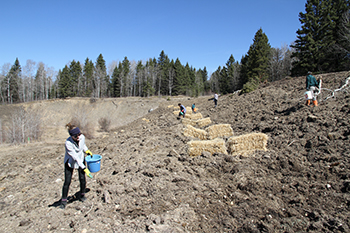
Grey Owl Landfill Site Restoration: This area of the park was a borrow pit used to create highways 10 and 19 and was also used as a domestic waste dumping ground for 30 years. The site falls within the Clear Lake watershed and was rehabilitated to reduce nutrients from entering Clear Lake. Work was done to restore native vegetation cover to three hectares of degraded habitat. The site will continue to be monitored.
Improving Access to Spawning Habitat by Restoring Connectivity
Restoring flow within Clear Lake tributaries is critical to ensuring the fish have access to spawning habitat. Over the years, these connections were cut off through human-made alterations and development. RMNP is working to re-establish these connections.
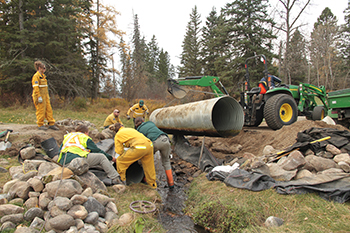
- Bogey Creek: Human-made alterations to Bogey Creek including culverts and bridges made detrimental impacts on fish health and spawning. Significant improvements have been made over the years to fish habitat and riparian health along Bogey Creek at the Clear Lake Golf Course and the Wishing Well. Culverts and other structures that were causing issues with stream flow were removed or upgraded to increase flow dynamics. After these changes, several hundred white suckers were able to make it through the large culvert up past Highway #10! Now Bogey Creek is on track to being restored as a more natural flowing system which should increase fish habitat quality and spawning areas.
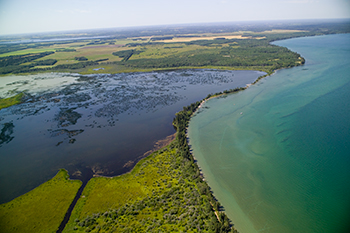
- Octopus Creek/Ominik Marsh/South Lake: Octopus Creek used to naturally drain directly into Clear Lake until a dike was constructed, either in the 1930s or late 1950s/early 1960s, diverting it into South Lake via Ominik Marsh. As a result, access to the creek from Clear Lake for fish is impaired. RMNP hopes to establish a permanent connection to support pike spawning. Research completed on northern pike movement in 2010 found South Lake is an important spawning and nursery area for pike. The research found the pike travelled from Clear Lake to South presumably to spawn, when the isthmus between the two lakes opened in early spring, and the majority returned to Clear Lake by the end of the summer before the isthmus closed.

- Glen Baeg Creek: Work on Glen Baeg Creek started in 2006, when impediments to fish movement were removed from the culvert on the creek. Work was also done to build up the stream bed to permit fish movement through the culvert, followed by monitoring to ensure that the modifications were effective.
The seven remaining sub-basins include six creeks – Aspen, Spruces, North Shore, Picnic, and Pudge – that also flow into Clear Lake. The single outflow from Clear Lake is Clear Creek, also known as Wasamin Creek, which drains from the western end of the lake, flowing approximately 12 kilometres to the Little Saskatchewan River.
Water Quality Monitoring & Managing Nutrient Levels

RMNP has tested and monitored Clear Lake’s water for around 40 years. These tests provide important information on water quality, nutrient levels (carbon, nitrogen, and phosphorus), and the trophic status of the lake. Managing and limiting nutrient inputs into Clear Lake is crucial to ensure the health of the lake and water quality.
The greatest concern is for coldwater species such as cisco, whitefish, and burbot. These species are important “indicators” of the health of the lake because they favour the naturally cold and clear conditions of Clear Lake. These species are the most sensitive to declines in dissolved oxygen in the lower depths of Clear Lake, which is related to nutrient (phosphorous) levels. As the lake is fertilized by phosphorous, more algae growth occurs, creating decomposed matter on the lake bottom. Decomposed matter uses up more oxygen in the water near the bottom of the lake, resulting in poor conditions for whitefish. Low phosphorous levels provide an ideal habitat for these coldwater fish species.
The main tests used to determine water quality are:
- Secchi Disk readings to monitor water clarity (indicated by the depth that light can penetrate the water)
- Chlorophyll a concentrations to measure algal abundance.
- Total phosphorus concentration – Continued high inputs can reduce water clarity and change the fundamental characteristics of the lake.
- Fecal coliform counts – This indicates the safety of the water for recreational purposes.
RMNP undertook the following actions to limit nutrient inputs into the lake:
- Infrastructure improvements to capture nutrients
- Rehabilitating/re-vegetating 0.5km degraded Clear Lake shoreline in the boat launch areas
- Cottage owners – working with and educating cottage owners on the importance of maintaining shoreline vegetation and limiting the use of products that could run off into the lake and increase nutrient levels
- North Shore cottage area – dialogue with cottagers began regarding illegal off-lot developments and activities involving land clearing, private docks and overnight mooring.
- East End & Aspen Day Use Area - the "no-mow" areas were restored along the shoreline and then widened from 2015 - 2017.
Improvements to Wastewater Infrastructure
Extensive development along Clear Lake’s shoreline (group camps, Clear Lake Golf Course, cottage subdivisions) and in the Rural Municipality of Park (seasonal home and resort development) have necessitated improvements to the townsite’s wastewater infrastructure. The first phase of improvements were completed in 2008.
These included:
- The replacement of the wastewater forcemain
- Increased capacity of the sewage lagoon
- Alum used to precipitate phosphorus out of the effluent
- More properties hooked up to the townsite’s wastewater treatment system and not using septic systems.
A report in 2012 found that after the wastewater infrastructure overhaul, improvements were seen in water clarity as well as phosphorus and algae levels. Dissolved oxygen levels are still a concern, and can dip below levels that are able to support certain native fish populations in late summer (e.g. whitefish). Limiting nutrient (phosphorus) inputs is necessary to improve O² conditions in Clear Lake, and the situation has improved by these upgrades.
Aquatic Invasive Species Prevention
For more information, please visit: Facts and FAQs about AIS
- Date modified :